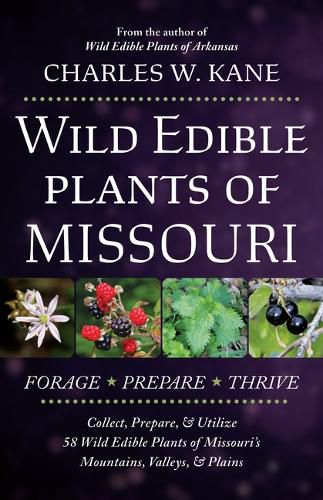Readings Newsletter
Become a Readings Member to make your shopping experience even easier.
Sign in or sign up for free!
You’re not far away from qualifying for FREE standard shipping within Australia
You’ve qualified for FREE standard shipping within Australia
The cart is loading…






Mainly divided into three terrain divisions - valleys/bottomlands, plains, and mountains (Ozarks), Missouri's plant life reflects this, and is somewhat variable. For the forager, this demarcation translates to variety and even abundance. With Wild Edible Plants of Missouri, the enthusiast has a simple guide to this translation, that is, the state's most abundant and useful wild edible plants.
A discussion of each plant's edible use and preparation is the publication's primary aim, though space is also given to range and habitat, medicinal uses (if applicable), cautions, and noteworthy special considerations. Helpful additions include sustenance ratings (low, medium, or high), collection timing and desired plant-part indicators, county-by-county map-image, over 160 color photos, and a general index.
Plant list: Amaranth, American Hazel, Arrowhead, Asparagus, Autumn Olive, Beefsteak Plant, Black Cherry, Black Nightshade, Black Walnut, Blackberry, Blackhaw, Blackseed Plantain, Blueberry, Cattail, Chokecherry, Clearweed, Dayflower, Daylily, Dewberry, Elder, Garlic Mustard, Gooseberry, Greenbrier, Ground Cherry, Hackberry, Hickory, Kudzu, Lambsquarters, Lemonade Berry, Lotus, Mayapple, Nettle, Oak, Panicgrass, Passionflower, Pawpaw, Persimmon, Pokeweed, Prickly Pear, Purslane, Redbud, River Cane, Salsify, Serviceberry, Sorrel, Sow Thistle, Spatterdock, Spiderwort, Spring Beauty, Thistle, Watercress, Wild Grape, Wild Onion, Wild Plum, Wild Rose, Wintercress, Yellow Nutsedge, and Yellowdock.
$9.00 standard shipping within Australia
FREE standard shipping within Australia for orders over $100.00
Express & International shipping calculated at checkout
Stock availability can be subject to change without notice. We recommend calling the shop or contacting our online team to check availability of low stock items. Please see our Shopping Online page for more details.
Mainly divided into three terrain divisions - valleys/bottomlands, plains, and mountains (Ozarks), Missouri's plant life reflects this, and is somewhat variable. For the forager, this demarcation translates to variety and even abundance. With Wild Edible Plants of Missouri, the enthusiast has a simple guide to this translation, that is, the state's most abundant and useful wild edible plants.
A discussion of each plant's edible use and preparation is the publication's primary aim, though space is also given to range and habitat, medicinal uses (if applicable), cautions, and noteworthy special considerations. Helpful additions include sustenance ratings (low, medium, or high), collection timing and desired plant-part indicators, county-by-county map-image, over 160 color photos, and a general index.
Plant list: Amaranth, American Hazel, Arrowhead, Asparagus, Autumn Olive, Beefsteak Plant, Black Cherry, Black Nightshade, Black Walnut, Blackberry, Blackhaw, Blackseed Plantain, Blueberry, Cattail, Chokecherry, Clearweed, Dayflower, Daylily, Dewberry, Elder, Garlic Mustard, Gooseberry, Greenbrier, Ground Cherry, Hackberry, Hickory, Kudzu, Lambsquarters, Lemonade Berry, Lotus, Mayapple, Nettle, Oak, Panicgrass, Passionflower, Pawpaw, Persimmon, Pokeweed, Prickly Pear, Purslane, Redbud, River Cane, Salsify, Serviceberry, Sorrel, Sow Thistle, Spatterdock, Spiderwort, Spring Beauty, Thistle, Watercress, Wild Grape, Wild Onion, Wild Plum, Wild Rose, Wintercress, Yellow Nutsedge, and Yellowdock.